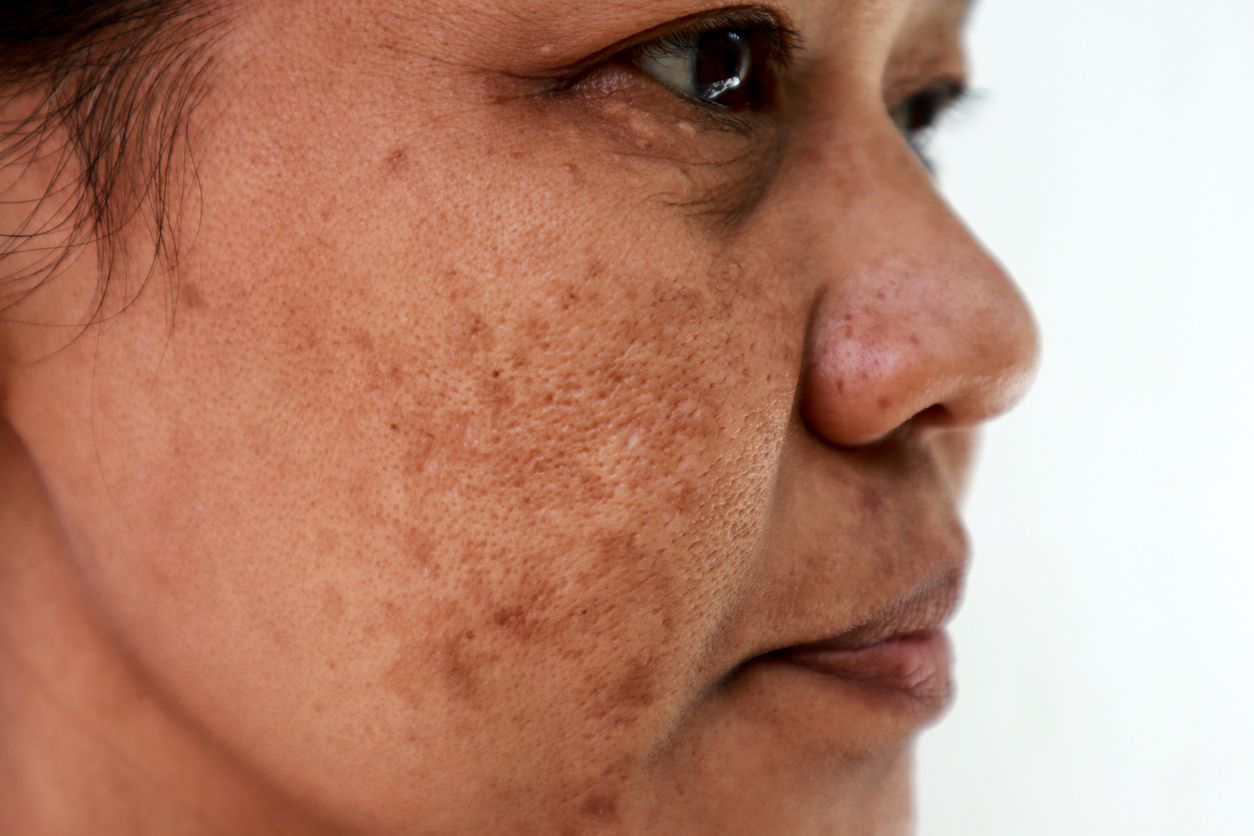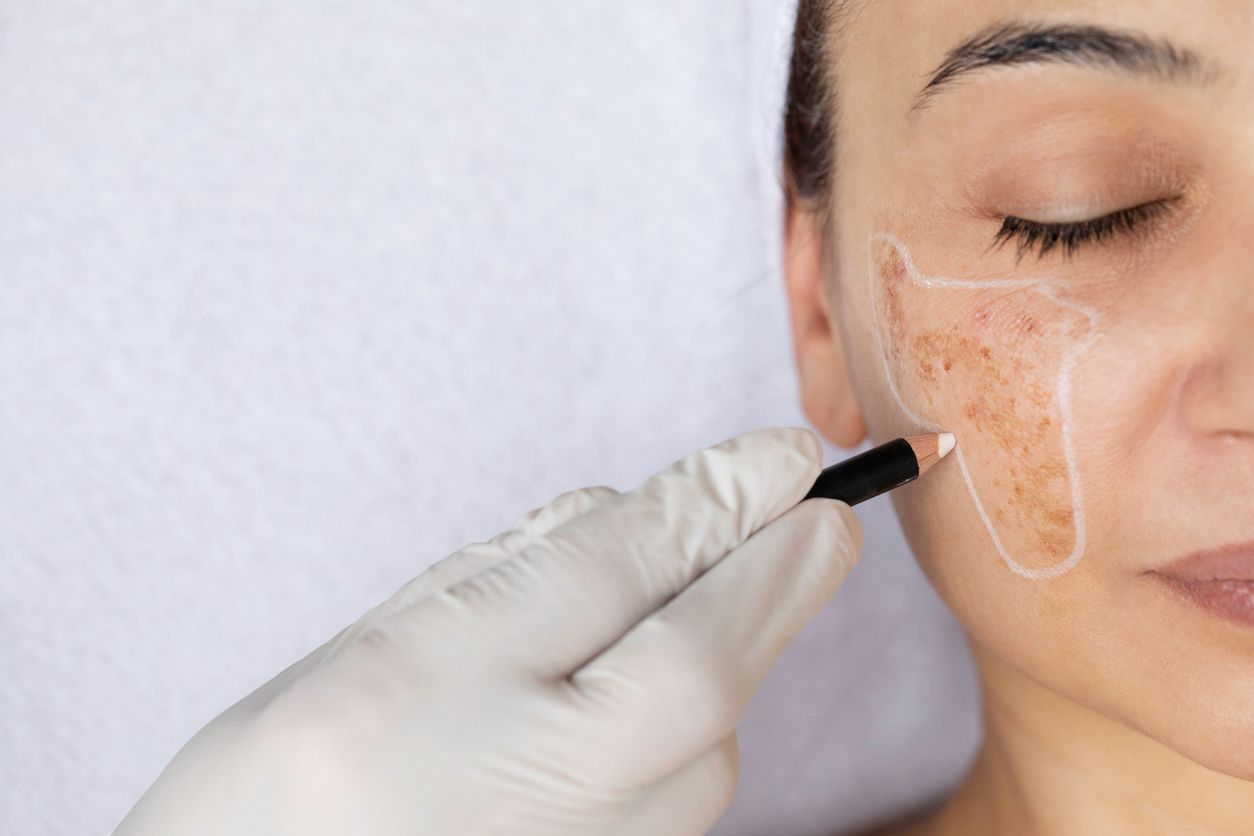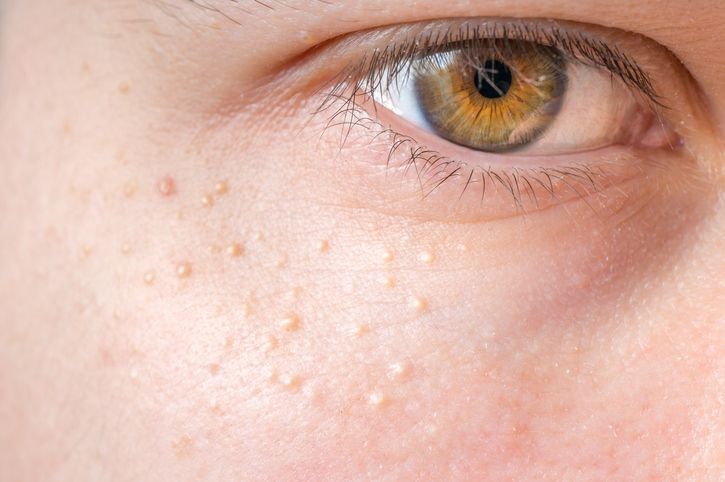- Home
- Trend
- Weight Loss Strategies
- Acne Tips
- Hair Health Information
- Blemish Removal Tips
- Acne Scar Removal Tips
- Muscle Building Techniques
- Intimate Care Tips
- Postpartum Intimate Care
- Eye Bags Wiki
- Tips for Face Slimming
- Secret of Permanent Hair Removal
- Breast Enlargement Tips
- Cure to Snoring
- Marionette Lines
- Skin-Tightening Secrets
Melasma, often called the "mask of pregnancy," affects millions worldwide, leaving its characteristic brownish pigmentation across facial features. While traditional treatments have shown mixed results, modern approaches are revolutionising how we treat this persistent skin condition. Let's dive deep into understanding and treating melasma with the latest scientific advances and proven strategies.
The Science of Melanin Synthesis

At its core, melasma stems from overactive pigment cells producing excess melanin. This process isn't simply a surface skin issue - it involves complex interactions between melanocytes, hormones, and environmental factors.
Location Matters: Why Melasma Appears Where It Does
Melasma’s characteristic appearance on certain facial areas is more than coincidental—it’s influenced by factors like sun exposure, hormonal changes, and skin structure. Typically, melasma shows up in three distinct facial patterns:
Centrofacial Pattern
This is the most common form, affecting areas like the forehead, cheeks, nose, upper lip, and chin. The prevalence in these regions is largely due to high exposure to UV rays and heat, which can intensify melanin production and worsen pigmentation.
Malar Pattern
This pattern focuses on the cheeks and nose. Often seen in individuals with a history of prolonged sun exposure, it tends to affect areas where the skin is thinner, making it more susceptible to pigmentation changes.
Mandibular Pattern
In this form, melasma appears along the jawline. This pattern is commonly linked to hormonal fluctuations, as the jaw area is more reactive to changes in the body’s hormonal balance. For many, hormonal shifts—especially those influenced by pregnancy or hormonal treatments—exacerbate pigmentation in this area.
5 Variables That You Should Know Before Deciding to Treat Melasma

Melasma is a complex skin condition characterised by dark, discoloured patches, primarily on the face. Understanding the underlying factors that contribute to its development is crucial for effective treatment. Here’s an elaboration on the existing reasons and additional factors influencing melasma treatment:
1. The Hormone Connection
Hormones play a significant role in the onset and exacerbation of melasma. Fluctuations in hormone levels, particularly oestrogen and progesterone, can trigger melasma in susceptible individuals. This connection is particularly evident during:
Pregnancy: Often referred to as the "mask of pregnancy," melasma can develop due to hormonal changes.
Oral Contraceptives: Birth control pills that alter hormone levels can also lead to melasma in some women.
Thyroid Disease: Conditions affecting thyroid function can influence skin pigmentation, potentially exacerbating melasma.
These hormonal influences explain why surface treatments alone may not suffice; addressing hormonal imbalances through medical intervention may be necessary alongside topical therapies.
2. The Hidden Impact of Visible Light
Recent studies have illuminated the role of visible light in aggravating melasma. While ultraviolet (UV) radiation has long been recognized for its damaging effects on the skin, visible light—particularly blue light emitted from screens and artificial sources—has been shown to contribute significantly to pigmentation issues:
Deeper Penetration: Visible light penetrates deeper into the skin than UV rays, causing more prolonged and persistent hyperpigmentation.
Increased Melanin Production: Research indicates that visible light can stimulate melanocytes, leading to increased melanin production and worsening of existing melasma patches.
3. Genetic Predisposition
Individuals with a family history of melasma or other pigmentation disorders may be more susceptible.
Genetic factors can influence skin type and response to environmental triggers, making some individuals more prone to developing melasma when exposed to certain stimuli.
4. Skin Type and Ethnicity
Melasma is more prevalent in individuals with darker skin types (Fitzpatrick skin types III-VI). The increased amount of melanin in these skin types can lead to a heightened response to triggers like sun exposure and hormonal changes.
Treatments may need to be tailored based on skin type to minimise risks of further pigmentation or adverse reactions.
5. Environmental Factors
Pollution and environmental stressors can exacerbate melasma by generating free radicals that damage skin cells and promote inflammation. This oxidative stress can lead to increased melanin production as a protective response.
Therefore, incorporating antioxidants into skincare routines may help mitigate these effects and enhance treatment efficacy.
免費體驗
PicoCure Pigmentation Removal Treatment
1 Minute Self-Registration
Date should not be before minimal date
Who’s at Higher Risk for Melasma? Key Factors to Know
Melasma, often marked by stubborn patches of pigmentation on the face, develops in response to a combination of internal and external factors. While melasma can affect anyone, certain individuals are significantly more susceptible due to specific risk factors. Here’s a closer look at who is most likely to develop this condition and why:
Darker Skin Types
People with medium to darker skin tones, including individuals of Asian, Hispanic, African, and Middle Eastern descent, are more prone to melasma.
These skin types naturally have higher melanin levels, which, while protective against some forms of sun damage, also increase the likelihood of pigmentation changes. This makes their skin more responsive to factors like hormonal fluctuations and UV exposure, heightening their melasma risk.
Female Gender
Women make up about 90% of melasma cases. This gender disparity is largely driven by hormonal influences, as fluctuating oestrogen and progesterone levels can stimulate melanocytes—the cells responsible for pigment production.
Pregnancy, often referred to as the "mask of pregnancy," and the use of hormonal contraceptives or hormone replacement therapy increase melasma susceptibility among women.
Hormonal Changes
Hormonal shifts are a major trigger for melasma. Pregnancy, hormonal birth control, and hormone replacement therapy can lead to an increase in melanin production, especially when combined with sun exposure.
In some people, even minor hormonal fluctuations may lead to increased pigmentation, making melasma a complex and multifactorial condition.
High Sun Exposure
UV rays are known to stimulate melanocyte activity, and consistent sun exposure is one of the leading triggers of melasma. Not only do UV rays deepen pigmentation, but prolonged heat exposure can also exacerbate the condition.
Outdoor activities without sun protection and high temperatures can worsen melasma or cause new patches to form, especially in people with darker skin tones.
Family History of Melasma
Genetics play a notable role in melasma risk. If family members have experienced melasma, there’s a higher likelihood of developing the condition.
Those with a family history of melasma tend to be more sensitive to triggers like hormonal changes and UV exposure, suggesting a genetic predisposition to pigmentation issues.
Use of Photosensitizing Skincare Products
Certain skincare ingredients, such as glycolic acid, salicylic acid, and retinoids, can increase the skin's sensitivity to sunlight. In those susceptible to melasma, these products can exacerbate pigmentation if used without sufficient sun protection.
When exposed to sunlight, skin treated with these ingredients is more vulnerable to UV damage, potentially triggering or worsening melasma.
Customization is Key: Your Options to Manage Melasma
Every individual's skin is unique, and so is their melasma journey. A tailored treatment plan, designed specifically for your skin type, severity of melasma, and lifestyle factors, is essential for optimal results. Your dermatologist will consider your specific needs and recommend a combination of treatments that may include:
Topical Creams and Serums
Topical creams and serums are often the first step in managing melasma, offering accessible, at-home options to lighten dark spots. Formulations containing ingredients like the follows ingredient may be helpful:
• Hydroquinone: This is a common ingredient in over-the-counter and prescription creams. It works by inhibiting tyrosinase, an enzyme involved in melanin production.
• Kojic Acid: Derived from mushrooms, kojic acid also inhibits tyrosinase and can help lighten melasma.
• Azelaic Acid: This naturally occurring acid has both anti-inflammatory and tyrosinase-inhibiting properties, making it effective for treating melasma.
• Tranexamic Acid: This acid works by blocking the formation of melanogenic factors, which stimulate melanin production. It can be used topically or orally.
• Glycolic Acid: An alpha hydroxy acid (AHA), glycolic acid can help exfoliate the skin and improve cell turnover, which can be beneficial for melasma.
When used consistently, these ingredients can significantly reduce melasma’s appearance. To maximise their effectiveness, combine them with daily sun protection to prevent further darkening.
Chemical Peel
Chemical peels involve the application of acid-based solutions to exfoliate the skin’s outermost layers, stimulating cell turnover and revealing fresher, less pigmented skin. For melasma, gentle acids like glycolic or lactic acid can be effective, helping to fade surface-level pigmentation and improve skin texture.
Chemical peels are available in varying strengths; professional treatments yield more noticeable results than over-the-counter peels. Depending on the melasma's severity, your skincare provider may recommend a series of peels spaced a few weeks apart for optimal improvement.
Laser Therapy: The PicoCure Pigmentation Removal Treatment
PicoCure Pigmentation Removal Treatment represents a breakthrough in melasma treatment, harnessing advanced laser technology that precisely targets excess pigment without impacting surrounding healthy skin. Using four specific wavelengths, PicoCure can treat pigment at varying depths, making it suitable for both superficial and deeper layers of melasma.
Unlike traditional lasers, PicoCure uses ultra-short, picosecond pulses, minimising heat damage and reducing the risk of irritation or inflammation. This advanced pulse delivery enhances melasma treatment outcomes by focusing on pigment reduction with less downtime, which is particularly beneficial for those prone to pigmentation issues.
What to Expect in a PicoCure Treatment Course
The PicoCure treatment process begins with an initial consultation and comprehensive skin analysis to determine the depth and characteristics of your melasma. Based on this assessment, a customised treatment plan is created, which typically includes:
• Personalised laser settings for precise treatment
• A series of sessions scheduled 4-6 weeks apart, allowing the skin to heal and pigmentation to fade progressively
• Combination therapy with topical creams or serums to enhance results and support skin recovery
PicoCure has demonstrated substantial success in treating both epidermal and dermal melasma, making it an excellent option for those seeking a non-invasive, targeted approach.
Intense Pulsed Light (IPL) Therapy
IPL therapy offers another effective treatment for melasma by delivering broad-spectrum light to the skin. This light penetrates the skin to reduce pigmentation and inflammation without impacting surrounding tissue. IPL can specifically target areas of melanin overproduction, helping to fade dark spots and even out skin tone.
For melasma patients, IPL can be beneficial when combined with other topical or procedural treatments, enhancing overall results while being relatively gentle on the skin.
Trigger Management: Minimising the Risk of Melasma Recurrence
Effectively managing triggers can go a long way in preventing melasma from reappearing or worsening. By addressing specific factors that contribute to melasma, you can maintain clearer, more even-toned skin over the long term. Here are some targeted strategies:
Hormone Monitoring and Regulation
Hormonal changes, especially those related to pregnancy, contraceptives, or menopause, are well-known triggers for melasma. If you suspect that hormonal fluctuations are contributing to your condition, speak with a healthcare provider.
They can evaluate hormone levels and may suggest alternative birth control options or hormonal therapies that are less likely to aggravate melasma. In some cases, lifestyle changes, such as adjusting diet and exercise, may also help balance hormone levels naturally.
Sun Protection as a Daily Non-Negotiable
Sun exposure is one of the most significant triggers for melasma, as UV rays stimulate melanin production. Daily application of broad-spectrum sunscreen with an SPF of 30 or higher is essential to protect against both UVA and UVB rays. Consider adding a physical blocker, like zinc oxide or titanium dioxide, for extra defence.
Reapply sunscreen every two hours if you're outside and wear a wide-brimmed hat and sunglasses for added protection. Consistent sun protection can help prevent existing pigmentation from darkening and reduce the chances of new melasma spots forming.
Stress Management Techniques
High levels of stress can lead to increased cortisol production, a hormone that can exacerbate melasma by causing inflammation and disrupting skin health.
Practising regular stress-reduction techniques, like meditation, yoga, or deep breathing exercises, can be incredibly helpful in managing these effects. These practices not only help balance hormones but also lower inflammation, creating a more stable internal environment that can lessen the intensity or recurrence of melasma.
免費體驗
PicoCure Pigmentation Removal Treatment
1 Minute Self-Registration
Date should not be before minimal date
Melasma Lesions are Not the End
Successfully treating melasma requires a comprehensive understanding of its causes and a multi-faceted treatment approach. As long as you start combining advanced treatments with proper sun protection and maintenance therapy, significant improvement is achievable!
PicoCure Pigmentation Removal Treatment免費體驗
PicoCure Pigmentation Removal Treatment
1 Minute Self-Registration
Date should not be before minimal date
FAQ

1. How do topical agents help in treating melasma, and what precautions should be taken to avoid skin irritation?
Topical agents, such as hydroquinone, azelaic acid, and tranexamic acid, are often used in melasma treatments due to their ability to reduce pigmentation. However, some may cause skin irritation, especially on sensitive or already affected skin. To minimise irritation, it’s best to start with a lower concentration (e.g., 2–4% for some agents) and gradually increase usage as the skin adjusts.
2. Can melasma be effectively managed with sunscreen alone, or is a combination approach necessary?
While using sunscreen is essential, especially one combining protection against both UVA and UVB rays, a combination approach is typically more effective for managing melasma. Sunscreens containing iron oxides provide additional protection by blocking visible light, which is another factor in pigmentation. Combining sunscreen with topical treatments like tranexamic acid or a triple combination cream (which includes hydroquinone, tretinoin, and a corticosteroid) can help prevent worsening of the condition due to ultraviolet radiation exposure.
3. What are the different treatment options available for managing epidermal melasma, and how are they selected?
Treatment options for epidermal melasma include topical treatments such as hydroquinone, tranexamic acid, and triple combination creams. Other approaches include chemical peels, laser treatments, and in some cases, oral tranexamic acid. The choice of treatment depends on factors like the depth of the pigmentation and the patient’s skin sensitivity. For many, a regimen starting with topical agents and avoiding direct sun exposure provides a solid foundation, while laser treatment may be added for more resistant cases.
4. How does pregnancy affect melasma, and are there safe treatment options for pregnant women?
Pregnancy can trigger melasma due to hormonal changes, as increased oestrogen levels can stimulate melanocytes in the skin, leading to pigmentation. Many melasma treatments, such as hydroquinone and some topical steroids, are not recommended for pregnant women. Instead, safer options include using broad-spectrum sunscreen with iron oxide and gentle topical treatments like azelaic acid.
5. What role does ascorbic acid play in melasma treatment, and can it be used with other topical treatments?
Ascorbic acid, or vitamin C, is an antioxidant that can help brighten the skin and reduce pigmentation, making it useful in melasma treatments. It works well in combination with other topical treatments, such as tranexamic acid or azelaic acid, to enhance the overall lightening effect without causing major skin irritation. However, it’s best to avoid combining ascorbic acid with strong acids or retinoids in the same routine to reduce the risk of irritation on affected skin.









